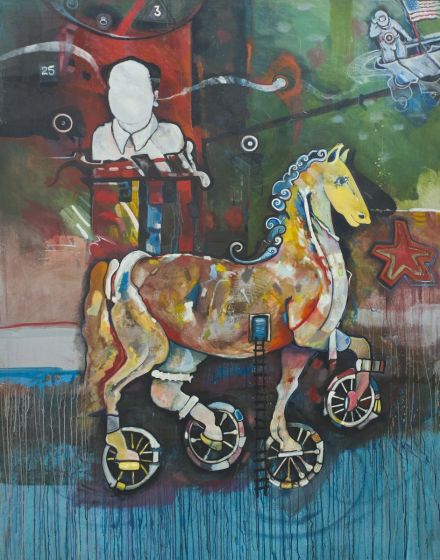Trojan Horse
Rudolf Kohn
Trojan Horse
W x H: 62.000000 x 79.000000 in / 157.48 x 200.66 cm
Canvas
This is a Unique work
$10,000.00
Shipping rates vary by destination
Need help? Call us at +1 408 599 8857
Reference No:
GP-0001365-01
Dimensions:
W x H: 62.000000 x 79.000000 in / 157.48 x 200.66 cm
MADE IN CHINA
This series of work is a symbolic representation of the current economic crisis between China and the United States. China is the largest foreign holder of the United States, owning eight percent of the States’ national loan debt – and due to growing economic interdependence, American culture remains indebted to the interests of the Chinese government. In the first painting of the series entitled “Caballo de Troya” (The Trojan Horse), Kohn demonstrates the “gifting” of a Trojan horse to the United States from China. The horse was a tool utilized by Ancient Greece to trick the enemy into thinking they were victorious, when in fact there were soldiers hiding inside of the horse, waiting patiently to destroy and conquer their opponent. The faceless man on the upper left is a representation of Mao Zedong, the first leader of communist China, and the astronaut on the upper right is a representation of the United States. Years have passed since the economic relationship between the two countries began, and the United States has realized the magnitude of control China has over world affairs. The second painting of the series, entitled “Tranpoline Mao Zedong,” displays Mao Zedong jumping into a meat-grinder and creating an output of products, represented by stars. In the third painting, “Transformation of Mao Zedong Into a Meat Grinder,” we see Mao’s face actually become the meat grinder, embodying the machine itself. All paintings in the series are varied interpretations of this imagery: the United States has been tricked, and it will be a long journey back to balance.
This series of work is a symbolic representation of the current economic crisis between China and the United States. China is the largest foreign holder of the United States, owning eight percent of the States’ national loan debt – and due to growing economic interdependence, American culture remains indebted to the interests of the Chinese government. In the first painting of the series entitled “Caballo de Troya” (The Trojan Horse), Kohn demonstrates the “gifting” of a Trojan horse to the United States from China. The horse was a tool utilized by Ancient Greece to trick the enemy into thinking they were victorious, when in fact there were soldiers hiding inside of the horse, waiting patiently to destroy and conquer their opponent. The faceless man on the upper left is a representation of Mao Zedong, the first leader of communist China, and the astronaut on the upper right is a representation of the United States. Years have passed since the economic relationship between the two countries began, and the United States has realized the magnitude of control China has over world affairs. The second painting of the series, entitled “Tranpoline Mao Zedong,” displays Mao Zedong jumping into a meat-grinder and creating an output of products, represented by stars. In the third painting, “Transformation of Mao Zedong Into a Meat Grinder,” we see Mao’s face actually become the meat grinder, embodying the machine itself. All paintings in the series are varied interpretations of this imagery: the United States has been tricked, and it will be a long journey back to balance.
Laura Henwick

